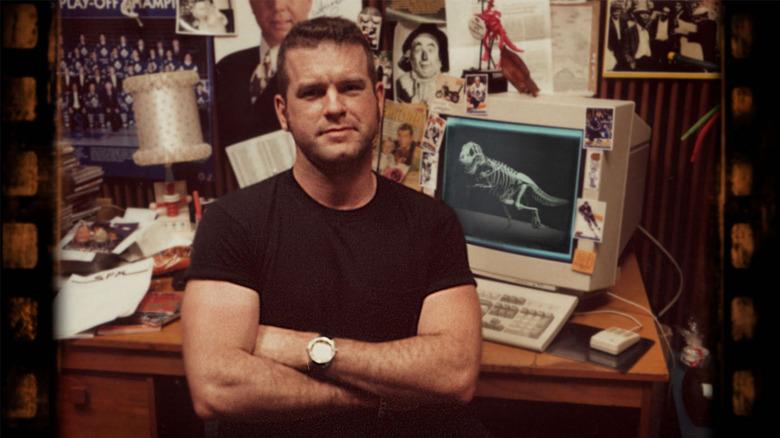Spaz Review: A Fascinating But Tragic Profile Of The Rebel Who Pioneered Modern Day CGI VFX [SXSW]
For better and worse, Hollywood was forever changed by the computer-generated visual effects pioneered for the rippling water creature in "The Abyss," the reflective, liquid chrome of the T-1000 in "Terminator 2: Judgment Day," and the awe-inspiring dinosaurs of "Jurassic Park." There's a good chance you've heard about the incredible work that special effects house Industrial Light & Magic (ILM) completed on those movies. But you might not have heard of the man who actually made it possible.
With an education in both computer engineering and animation inspired by the blue-collar work and unrealized cartoon dreams of his father, Steve "Spaz" Williams started his career in animation far away from Hollywood in Canada, and it wasn't exactly what you'd call creative work. He was employing animation for the most mundane of uses, recreating real-world environments for simulations, such as a cooling system for a Gatling gun situated on battleships.
This was a time when very few people knew how to do anything on a computer, let alone realistically replicate real-life elements like water with three-dimensional computer graphics. So when ILM was having trouble figuring out how to create the liquid pseudopod for a sequence in James Cameron's film "The Abyss," Spaz — with the right knowledge of computers, animation, and fluid dynamics — was the perfect man for the job. What he didn't know was that he was about the change filmmaking forever.
Rebel with a computer
Spaz's career at ILM began with "The Abyss," which made him fast friends with Mark Dippé, who also worked tirelessly on "Terminator 2" and "Jurassic Park." Initially, both were immediately put off by each other's look and demeanor. Spaz donned a crew cut, tight white t-shirt, and jeans cuffed up above engineer boots like John Milner in "American Graffiti," while Dippé looked like a bespectacled, long-haired hippie. These two certainly didn't look like they'd work well together in the secluded ILM basement known as "The Pit." But as soon as Spaz heard Dippé playing Alice Cooper's album "Love It to Death," the first album either of them ever bought, they hit it off. What followed was a career of innovation and rubbing people the wrong way, including a special effects legend who isn't exactly painted in the best light here.
As a documentary, "Spaz" accomplishes two things. First, it chronicles Spaz's place in the rise of modern CGI VFX across the three aforementioned blockbusters, complete with warts-and-all insights from those who were actually there behind the scenes. There's incredible footage of Robert Patrick (who is also interviewed for the doc) in his skivvies with graph markers drawn all over his body as he executes his intimidating T-1000 walk for computer reference. We get to see the early animation tests for the CGI T-Rex that would blow audiences away in "Jurassic Park," an innovation that only came about because Spaz defied orders from the higher-ups and opted to showcase how computer animation could be used to depict lifelike dinosaurs — sneakily catching the eye of producers Kathleen Kennedy and Frank Marshall as well as director Steven Spielberg. And that's where an unfortunate rivalry and bitterness comes along that would ultimately be the undoing of Spaz.
In Hollywood, Dennis Muren is a VFX legend who made a name for himself on the original "Star Wars" trilogy with George Lucas and is known for being a master of stop-motion animation and creature effects in some of the biggest blockbusters of all time. But "Spaz" reveals a different side to Muren, one that doesn't seem to have a problem with taking credit for innovations that he either had nothing to do with or greatly resisted before they were acclaimed by the rest of the industry. Many of ILM's most prominent creators at the time acknowledge that the game-changing effects work done on "The Abyss," "Terminator 2", and "Jurassic Park" could not have been accomplished without Williams, and yet he's never been recognized with an award of his own, and he wasn't even thanked when Muren and some of the other ILM cohorts accepted Academy Awards for his work.
Now, this might speak to a larger issue in the industry, where many of the crucial people working behind-the-scenes on the most respected films go unacknowledged, but the documentary "Spaz" certainly portrays Muren (and some of the other higher-ups at ILM) as dismissive and ungrateful of Williams' contributions. That might be because a lot of ILM's old guard was worried about computer-generated imagery making their hands-on effects work obsolete in Hollywood (and they weren't necessarily wrong, as many VFX experts note the rise in subpar CGI VFX work that followed), but it may have also been because of Spaz's unconventional, rebellious, and cavalier attitude, as well as his unwillingness to play Hollywood's glad-handing political games. And that's what the other side of "Spaz" focuses on.
'I had it all, and it all went away'
Spaz's influential work saw him being named among George Lucas and Tom Cruise as one of the most influential people in Hollywood at the time. Can you imagine a singular computer animator being named among Hollywood's titans today? This was a big deal, but it wouldn't keep Spaz from bringing about his own downfall. Woven throughout "Spaz" is the more tragic side of this man's story.
Director Scott Leberecht, a colleague and friend of Williams, also has "Spaz" dig into how the animator's rebellious attitude and self-destructive behavior simply didn't sit well with the much more formal and reserved side of Hollywood's bureaucracy and business. The man — who occasionally looked like a stand-in for Wolverine, with his tight t-shirts, leather jacket, and trimmed mutton chops — simply didn't know how to play the Hollywood game. As Spaz admits, "I'm not a diplomat. I never have been. To a fault, I've been a very bad diplomat ... I look like f**kin' Popeye."
"Spaz" illustrates the creative's own struggles in his personal life, which includes a natural immaturity and a struggle with alcoholism, both of which led to the crumbling of not just two romances but his professional relationships as well. After a "Jurassic Park" publicity tour saw Spaz being blatantly honest in the press about pushing back against the powers-that-be at ILM to bring about the innovation that gave audiences stunning blockbuster dinosaurs, Spaz wasn't exactly friendly with the right people at ILM. Furthermore, he put a bit of a target on his back when making seemingly bold, controversial predictions about actors not only appearing on-screen with characters created with computer animation but actors being entirely created with VFX, even if they happened to be long dead. Despite the fact that he would go on to be 100% correct, the manner in which he addressed these innovations and the complaints lodged against them resulted in what Muren told Spaz was "political suicide."
In this case, Muren wasn't wrong, and despite finding success with movies like "The Mask" and carving out a space for himself in computer animation for advertising, Spaz eventually got out of control, and not even ILM would have him back after their professional fallout. As it all comes tumbling down, "Spaz" focuses on Steven Williams, not as a VFX innovator, but a man reflecting on his own shortcomings and problems. While there might be an argument to be made for how this prescient mind was treated by the old guard of effects masters who were too worried about losing their small piece of Hollywood history, Williams knows that he's also to blame for his place in life. Sadly, he's still struggling to this very day, painting a portrait that is both inspiring and tragic.
"Spaz" tells an intimate story that unfolds within a milestone moment in moviemaking history. The film occasionally has trouble balancing the two subjects, with the more personal side of the doc occasionally getting lost in the archival clips and photos of the Hollywood fervor Spaz stirred up with his innovations. But it's still fascinating, insightful, and certainly entertaining. Leberecht does an admirable job of wading through the intertwined story of how Spaz changed Hollywood forever, all while Hollywood had no chance of changing the chaotic creative force that is Spaz.
/Film Rating: 8 out of 10

